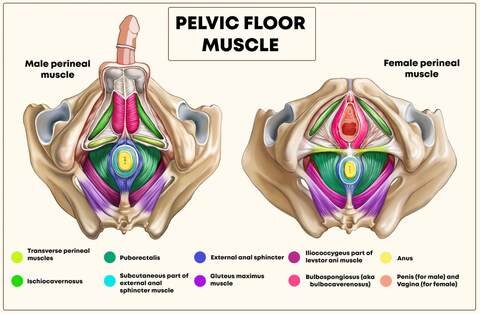The foundation to your core and deeply connected to your nervous system, emotional health, and well-being.
When considering all the aspects of a holistic wellness practice, it’s beyond important to consider the pelvic alignment, as well as work to balance movement with stillness and strength with softness, especially for women. Both men and women have a pelvic floor and can experience dysfunction, but more women (1 in 4) will experience dysfunction within their lifetime.
Anatomy of the Pelvic Floor
The pelvic floor consists of bone, muscles, and connective tissue which provides support to the pelvic girdle, spine, and organs and assist in urinary, defecatory, and sexual function. In order for these functions to operate effectively, relaxation and contraction and coordination of the pelvic floor muscles is required.When this balance of contract/relax is impaired, various symptoms can present themselves.
Development of Dysfunction
Over time, both weakening (developing hypotonic muscle tone) and excessive tension (hypertonicity) of the PF musculature can lead to SI joint, hip, and back pain, balance and stability concerns, decreased athletic performance, incontinence, painful intercourse, and problematic pregnancies down the road. Misalignment or imbalance in the surrounding tissue that supports the pelvis can not only cause pelvic floor dysfunction, but issues anywhere in the body from your neck and shoulders all the way down to your feet.
Most common symptoms
Pain: low back pain, pelvic pain unrelated to intercourse, lower abdominal wall pain
Sexual function: insertional or deep dyspareunia, pelvic ache after intercourse
Urinary function: frequency, hesitancy, urgency, dysuria, bladder pain, urge incontinence
Bowel function: bloating, constipation, difficulty eliminating, straining, incomplete elimination
I work with many females who are currently working to find their balance with this. And for me personally, I have been working to correct my own dysfunction due to all my years of heavy lifting, cheerleading, lacrosse, hyper-flexibility (which over time has caused my pelvic floor muscles to attempt to stabilize my unstable pelvis), excessive coughing from random bouts of chronic bronchitis, and my lack of time and patience for pooping (also a result of dysfunction - sorry, but truth) 😳. Growing up as an athlete participating in impact sports, no one educated me on the importance of pelvic floor health. And that’s true for so many young athletes.
Re-Connecting To Your Pelvic Floor
It’s a common misconception that correction to dysfunction begins with kegels. Unfortunately, this might actually be the opposite of what you need. If you’re someone with hypertonicity in your PF, kegels will only further that dysfunction and it’s important to learn how to soften PF musculature. Whether you’re hyper/hypotonic or just starting with connecting to your PF, begin with the Breath.
If you’re experiencing any dysfunction symptoms, I highly recommend seeking out a PF physiotherapist to get an assessment and work in conjunction with a coach who is highly educated on PF health and dysfunction.
PF Connection Breathwork
Note: this is just a breathwork practice to create mindfulness and connection between your breath, diaphragm, and pelvic floor and is just the start to creating a holistic wellness practice for the pelvic floor.
Begin on your back if you’re new to breathwork or connecting to your pelvic floor. As you inhale, feel the diaphragm contract and move down towards the pelvis, allowing the belly to expand while relaxing and softening the pelvic floor muscles. As you exhale, lift and gently engage the pelvic floor slowly and expel the air out by continuing the contraction up to the lower belly, then to the ribcage, visualizing hugging the spine to fully engage the deeper core musculature. Hold the pelvic floor contraction gently throughout. Inhale while feeling the diaphragm move downwards, the belly expand, and the pelvic floor relax ...
Once comfortable, you can attempt in a comfortable seated position, and then move to leaning against a wall with the pelvis posteriorly tilted and back flush to the wall.
Let me know…
Are you able to create connection to your pelvic floor? Do you have a regular practice that has helped you with your pelvic floor health?
What other adjustments have you made to your lifestyle to support your pelvic floor health and wellness? Share your favorite tips in the comments below — others in the community might benefit from your recommendations!
Come connect with me on Instagram @running_with_forks
Do you have any questions not answered in this post? Comment below or send me a note so I can continue to add information to answer your questions.








